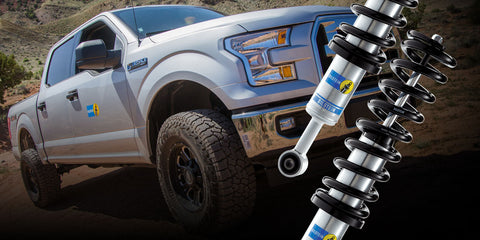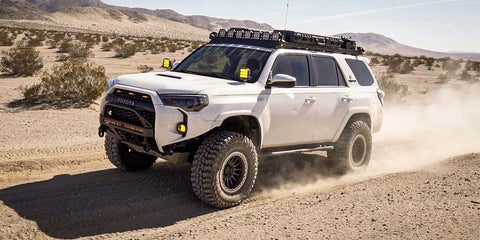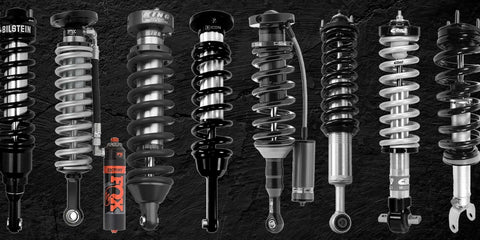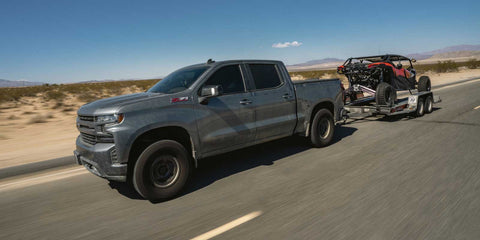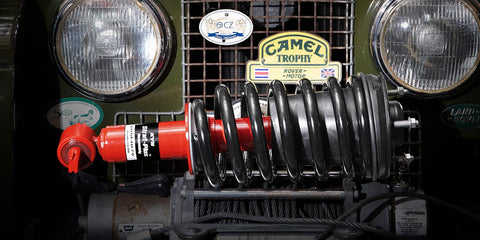Shock Absorber Designs - Emulsion, Foam Cell, Nitrogen Gas, Monotube, Reservoir
Posted by Brandon Sevestre on
Shock Technology 101
Twin Tube Shocks (Nitrogen Charged)
Twin tube shocks utilize an inner and outer tube which separates the oil and gas inside the damper (shock). The smaller diameter inner tube houses the piston shaft assembly, base valve, and oil. The outer tube contains both nitrogen gas and hydraulic shock oil.
- The twin tube shock design is the most common and found on a majority of vehicles.
- Design benefit with greater piston stroke to damper body ratio, meaning more piston movement in a smaller total package.
- More durable against road debris, and will continue to function as long as the inner tube is not damaged.
When a twin tube shock is gas charged, the purpose is to minimize aeration of the hydraulic fluid, this occurs when the shock is working hard and heating up. The nitrogen gas pressure compresses air bubbles in the hydraulic fluid, which prevents oil and air mixing (foam). Without aeration, the shock is able to function more efficiently and reliably.
Nitrogen Gas Twin Tube - These shocks are great for the general purpose driver, one who sees a lot of paved highway and roads, with the occasional off-road excursion on he weekends.
Twin Tube Shocks (Foam Cell)
A foam cell shock uses a compact foam sleeve inside the twin tube body, taking the place of a nitrogen gas charge. The foam cell is more compact than the nitrogen gas in terms of volume, leaving more room for hydraulic shock oil, which is the main cooling agent of the shock. Many foam cell shocks are developed for high heat environments, as they typically do better than Nitrogen Gas charged shocks in resisting fade through heavy use.
- Myth #1 - Once overheated and aerated, foam cell shocks dont return to normal. Not true, the foam cells may lose function over the very long term, but its not due to acute overheating from any one instance.
- Myth #2 - Foam Disintigrates over time. Not true for any decent quality shock absorber manufacturer. If you're buying no-name ebay parts, then maybe.
The difference in ride quality between a Nitrogen Gas or Foam Cell shock is determined solely by the valving, in which case both shock designs can be tuned to feel near identical on the same vehicle. Do not be misled by thinking one is firmer or softer than the other, that comes down completely to the valving of the shock, irrespective of being nitro-gas or foam-cell. Foam cell shocks are proven to take longer to overheat and reach a level where shock fade occurs, typically hotter than any driver will ever get them (200-300 degrees).
Monotube Shocks
Monotube shocks only use a single outer tube. The oil and gas are separated by a free floating piston which puts the oil on the top and gas on the bottom.
The monotube design is making its way to more and more factory vehicles, Toyota, Audi, and Porsche all have applications that run Bilstein from the factory. Mercedes Benz has been running monotube shocks on their vehicles since the 60s.
- The monotube contains larger active piston surface area, which means greater and more consistent damping force.
- Lower operating pressure leads to more consistent and controlled ride, though this may be experienced as a bit firmer than an emulsion shock on the highway, its not harsh
- Other benefits include increased oil capacity, improved heat dissipation, and longevity.
Adjustable Shocks
Monotube and Twin Tube designs both allow adjustability through external knobs and twisting mechanisms. There are single, and dual adjustable shocks, allowing multiple levels of compression tuning on the fly. Race level shocks like the Fox 2.5 Factory DSC shocks allow for low speed and high speed adjustment, allowing a softer highway ride while providing excellent feedback for higher speed off-road driving.
- Having compression and rebound adjustability allow the driver to setup the vehicle to be forward or rearward bias
- Ideal for drivers that spend a lot of time at the track or in off-road environments
Reservoir Shocks
Reservoir shocks, whether remote (connected with a hose), or piggyback (directly on the main shock body, usually connected by some form of hardware), increase a monotube shock’s capabilities significantly. In most cases, reservoir shocks are also monotube gas design for superior heat dissipation paired with superior travel, you will rarely see a reservoir on a twin tube or emulsion shock.
- With such a large volume of space for the oil and gas to operate in, this creates a more dramatic difference for internal operating pressures, thus usually increasing ride quality for the driver.
- Less pressure buildup, less component wear, longer life - buy reservoir shocks if you want an upgrade for life.
- Further heat dissipation due to increased volume and surface area
- Increased travel when compared to a normal monotube shock of the same size, this is due to the shared space for oil and gas that the main body now shares with the reservoir.
External Bypass Shocks
These are the high end race shocks that are featured on many trophy trucks and race vehicles, where there is sometimes a dizzying amount of tubes on the main shock body. Most of these tubes, if not all, will feature an adjustment valve, that limits the flow of shock oil through the tube.
The placement of the external tubes are specific to certain ride zones in the shock, this is why there are tubes closer to the middle, and tubes at the very ends of the shock. By limiting or increasing oil flow in these zones, you are able to tune a shock for certain speeds over a given terrain. This is why a truck’s wheels sometimes are floating / bouncing very consistently in a given zone when the truck is at a consistent pace. A lot of the oil is being allowed to bypass the main shock pistons in the middle ride zone, and when that piston hits the next zone is when the damping significantly increases to keep suspension in the preferred zone.
Internal Bypass Shocks
In a some cases, such as the King Shocks IBP shocks, there are cutouts from the active piston in the shock to allow the shock oil to flow through the valving (or shim stacks), in which case the oil then meets resistance on a secondary piston to activate the primary damping mechanism. This allows a certain amount of oil flow to occur without much resistance, which is usually specifically tuned for soft comfort in a certain ride zone.
Other shock designs with Internal Bypass, such as Old Man Emu BP51 shocks, there are cutouts along the internal shock tube, which allows the oil to flow freely through as the main piston is moving through the chamber. So when the piston is meeting resistance through the oil, a certain amount is allowed to go ‘around’ the piston, through the tube cutouts, and circulate to the other side of the chamber. This achieves similar results of less resistance in the optimized ride zone.
Emulsion Shocks
Emulsion shocks are designed to combine the shock oil and nitrogen gas into a single mixture, not separated by an internal piston or chamber. The term ‘emulsion’ is just a fancy way to describe these shocks, your typical hydraulic + nitrogen gas shock is an emulsion shock. Under aggressive shock use, this creates significant internal pressures as the oil cavitates and foams up, reducing dampening ability.
- Higher pressure means more wear on components, resulting in less durability than a shock that has less internal pressures (monotube and reservoir)
- Firmer / harsher ride comfort due to higher gas pressure and internal friction of components
- Pairing optimal springs and spring-rates is tougher due to how much the internal pressure of an emulsion shock affects vehicle performance and ride height
Air shocks have an air inlet, sometimes called a shrader valve, that allows the shock to be pressurised with air and pumped up to lift the vehicle. Air shocks are usually only installed on the rear of the vehicle and are common additions to trucks and vans carrying heavy loads. An air fitting is normally placed somewhere on the rear of the vehicle for an air chuck to be attached and inflation occurs with air from an air compressor or air tank. Lines run to the shocks from the air fitting and are usually attached to the frame with straps or clamps.


















